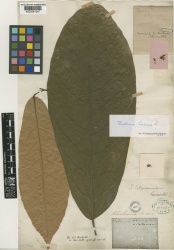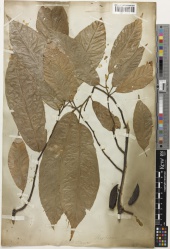Theobroma cacao (fruit)
From AHPA Botanical Identity References Compendium
(Difference between revisions)
(create page) |
(add Culbreth ref for macro) |
||
| (6 intermediate revisions by 2 users not shown) | |||
| Line 1: | Line 1: | ||
| − | {{DISPLAYTITLE: ''Theobroma cacao'' (fruit) }} | + | {{DISPLAYTITLE: ''Theobroma cacao'' (fruit) }} {{askbox|herb=''Theobroma cacao''}} |
=Nomenclature= | =Nomenclature= | ||
| + | |||
| + | {{nomenclature | binomial=Theobroma cacao | ||
| + | |authority=L. | ||
| + | |family=Sterculiaceae | ||
| + | |scn=cacao | ||
| + | |syn= | ||
| + | |ayurvedic= | ||
| + | |pinyin= | ||
| + | |aka= | ||
| + | |notes=This plant is sometimes referred to as “cocoa” or “chocolate,” but in fact those are names of food products manufactured from its fruit. }} | ||
=Botanical Voucher Specimen= | =Botanical Voucher Specimen= | ||
| + | {{Media2 |cat=Voucher | ||
| + | | companyimage=Kewlogo.gif | ||
| + | | companyURL=http://specimens.kew.org/herbarium/K000381047 | ||
| + | | mainimage=Theobroma cacao Kew barcode=K000381047 225205.jpg | ||
| + | | source=Royal Botanic Gardens, Kew. | ||
| + | |||
| + | | companyimage2=Kewlogo.gif | ||
| + | | companyURL2=http://specimens.kew.org/herbarium/K001132315 | ||
| + | | image2=Theobroma cacao Kew barcode=K001132315 713127.jpg | ||
| + | | source2=Royal Botanic Gardens, Kew. | ||
| + | }} | ||
=Organoleptic Characteristics= | =Organoleptic Characteristics= | ||
| + | {| border=1 | ||
| + | | | ||
| + | {{Organolepsy | source=United States Dispensatory (1918) | ||
| + | | description=Cacao beans have a slightly aromatic, bitterish, oily taste, and, when bruised or heated, an agreeable odor. }} | ||
| + | |} | ||
| + | |||
| + | =Macroscopic Characteristics= | ||
| + | {| border=1 | ||
| + | | | ||
| + | {{Macroscopy | source=Culbreth, D. (1917) A Manual of Materia Media and Pharmacology, 6th ed. | ||
| + | | description='''Plant:''' Handsome tree 9-12 M. (30-40°) high, round branches, bark gray, smooth; leaves 20-22.5 Cm. (8-9') long, 6 Cm. (2 2/5') side, lanceolate, acute, round base, entire, veins prominent beneath, petiole 2.5 Cm. (1') long, thickened at both ends; young leaves pink; flowers pale pink, calyx and corolla 2.5 Cm. (1') broad, alike in color. | ||
| − | = | + | '''Fruit:''' Large, 15-17.5 Cm. (6-7') long, broadly fusiform, with 10 shallow furrows and blunt ridges, tuberculated, pendulous, single or 2-3 together, at first yellow, then red, purple, pericarp thick, tough, 5-celled; seeds many, closely packed in tiers, size of almonds, angular from pressure, immersed in copious, sweet buttery pulp, seed-coats 2, brownish. |
| + | }} | ||
| + | {{Macroscopy | source=United States Dispensatory (1918) | ||
| + | | description=''Theobroma Cacao'' Linn. is a handsome tree, from twelve to twenty feet in height, growing in Mexico, the West Indies, and South America. [...] The fruit is an oblong-ovate capsule or berry, six or eight inches in length, with a thick, coriaceous, somewhat ligneous rind, enclosing a whitish pulp, in which numerous seeds are embedded. These are ovate, somewhat compressed, about as large as an almond, and consist of an exterior thin shell and a brown oily kernel. Separated from the matter in which they are enveloped, they constitute the cacao, or chocolate nuts, of commerce.}} | ||
| + | |} | ||
=Microscopic Characteristics= | =Microscopic Characteristics= | ||
| Line 17: | Line 53: | ||
<references /> | <references /> | ||
| − | |||
Latest revision as of 18:17, 7 July 2015
Contents |
Nomenclature
Theobroma cacao L. Sterculiaceae
Standardized common name (English): cacao
Botanical Voucher Specimen
 |
 |
|
|
|
Organoleptic Characteristics
|
Macroscopic Characteristics
|
Microscopic Characteristics
High Performance Thin Layer Chromatographic Identification
Supplementary Information
Sources
- ↑ Royal Botanic Gardens, Kew. http://specimens.kew.org/herbarium/K000381047
- ↑ Royal Botanic Gardens, Kew. http://specimens.kew.org/herbarium/K001132315
- ↑ United States Dispensatory (1918)
- ↑ Culbreth, D. (1917) A Manual of Materia Media and Pharmacology, 6th ed.
- ↑ United States Dispensatory (1918)

